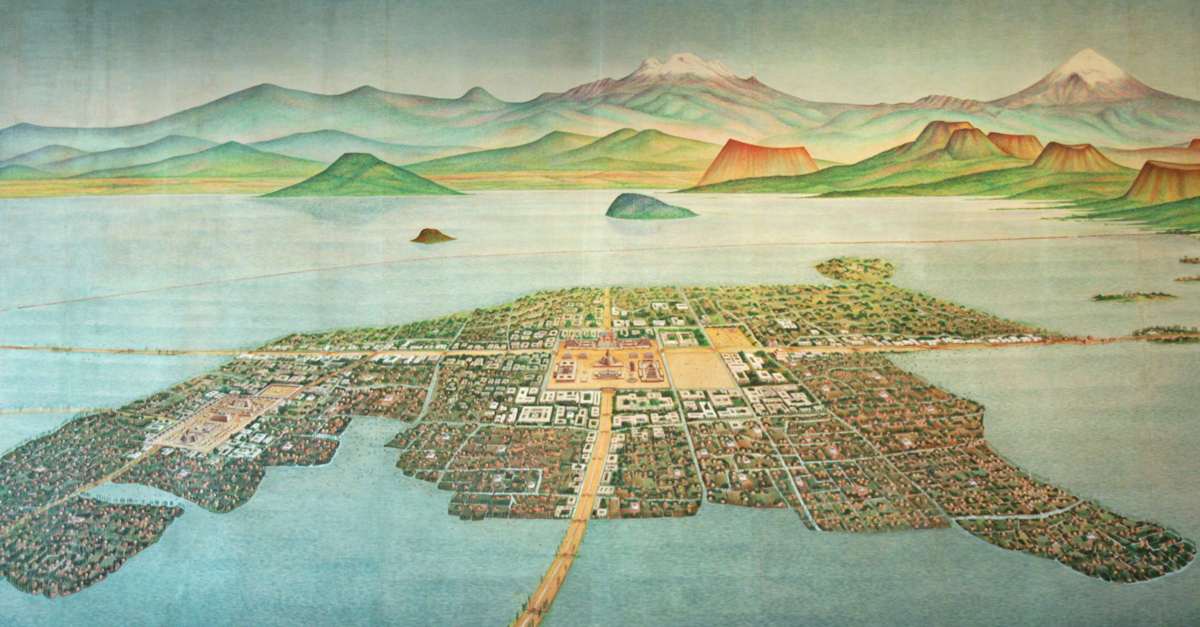Mexico City is one of the largest metropolitan areas in the world. Founded in 1524 by the Spanish, today the city proper covers nearly 600 square miles and has a population of over 9 million people. But the history of Mexico City stretches back almost two centuries before the Spanish ever set foot in the Americas. Rather, the Spanish built their capital on top of the ashes of one of the most beautiful and unique cities in history.
The Mexica
The Mexica people, known today as the Aztecs, founded the city of Tenochtitlan in 1325. According to legend, an ancient prophecy foretold that the Mexica would found a great city at a site signaled by an eagle with a snake in its beak, perched on a cactus—an image still enshrined on the Mexican flag today. After years of wandering, the Mexica discovered this portent on a tiny, marshy island in the middle of Lake Texcoco. Undeterred by the difficult location, they founded Tenochtitlan on the site.
A more likely origin is that the Mexica simply had nowhere else to go. They were latecomers to the Texcoco region, and some 50 settlements already surrounded the lake. A tiny, marshy island in the middle of the lake seems like a poor consolation prize—but the Mexica were resourceful and inventive. Life had given them lemons, and they made lemonade.
Floating Islands
Using chinampas—artificial islands made by fencing off areas of the shallow lakebed with reeds and then filling them with soil—the Mexica farmed directly on Lake Texcoco itself. What followed was abundance and prosperity.
Before long the Mexica, once newcomers on Lake Texcoco, dominated all the other city states in the region. By 1519, their empire spanned 80,000 square miles, stretching from the Atlantic to the Pacific. The Mexica ruled a population of around six million people—and it all centered around the wondrous city of Tenochtitlan.
A Metropolis Unlike Any Other
Though chinampas were originally used for farming, the artificial islands soon grew more permanent and served many functions. By the time of its height, Tenochtitlan looked nothing like the swampy island of its origins. In its place stood a sprawling metropolis, seemingly floating in the middle of the lake. An intricate network of canals wove through massive temples, thriving marketplaces, a luxurious palace, gardens, zoos, and even an aquarium, while three grand causeways connected the city to the mainland.
At its height, Tenochtitlan held 200,000 to 400,000 people, making it one of the largest cities in the world—five times the size of London at the time. When Spanish conquistadors first laid eyes upon the sprawling lakebed metropolis, some of them thought they were dreaming. But if it was a dream, it was about to come to an end.
Erased
Though the Mexica possessed remarkable ingenuity and a complex culture, they were no match for the military might of Hernán Cortés and his Spanish conquistadors. In 1521, Cortés conquered the city after a long siege. According to stories, tens of thousands of Mexica bodies floated in the city’s canals by the time the fighting had stopped.
As soon as he had control, Cortés set about leveling Tenochtitlan, building Mexico City upon the ruins. The Spanish then drained Lake Texcoco in order to control flooding, and it wasn't long before the beautiful city in the middle of a shining lake was nothing but a distant memory.














